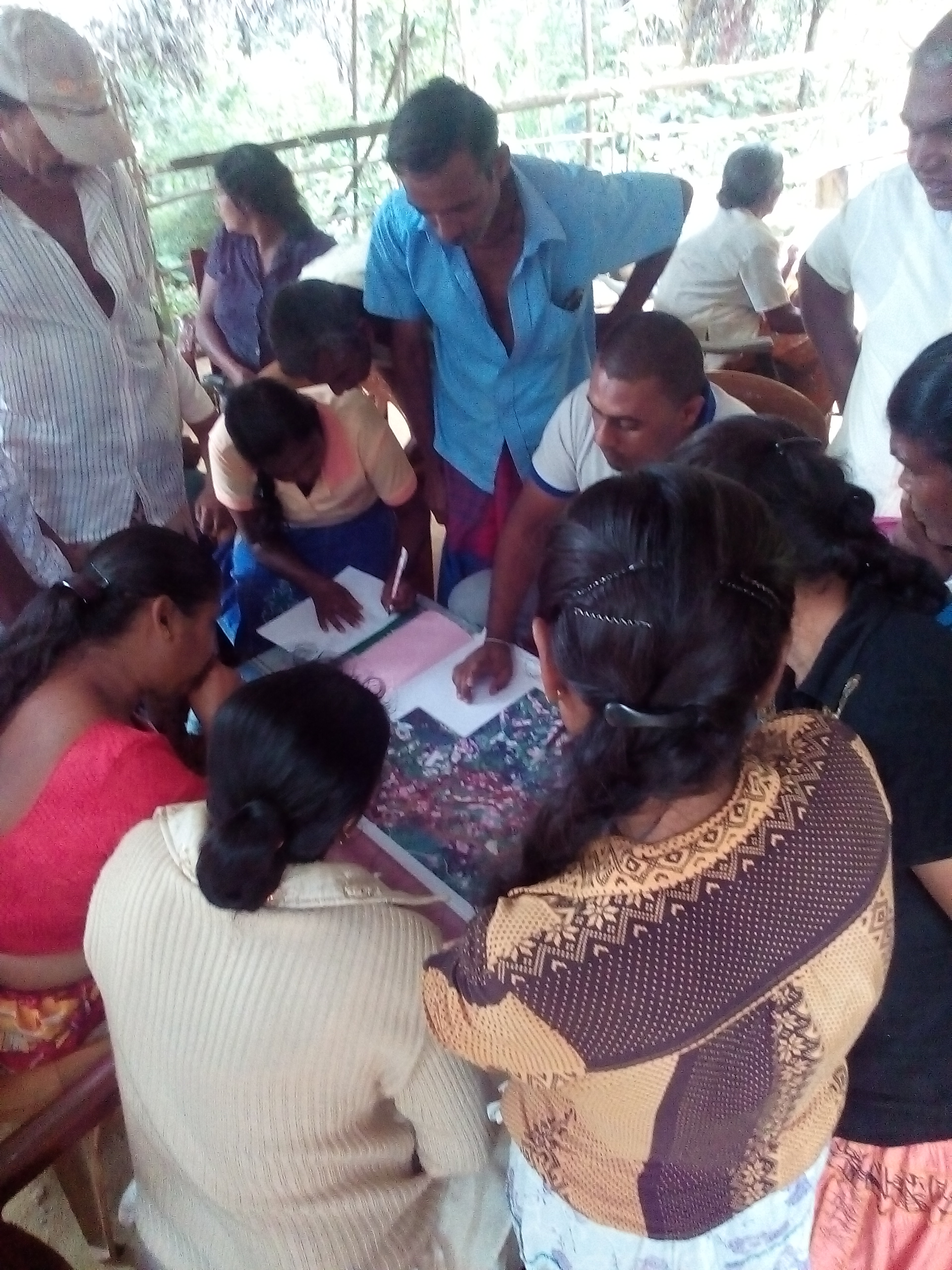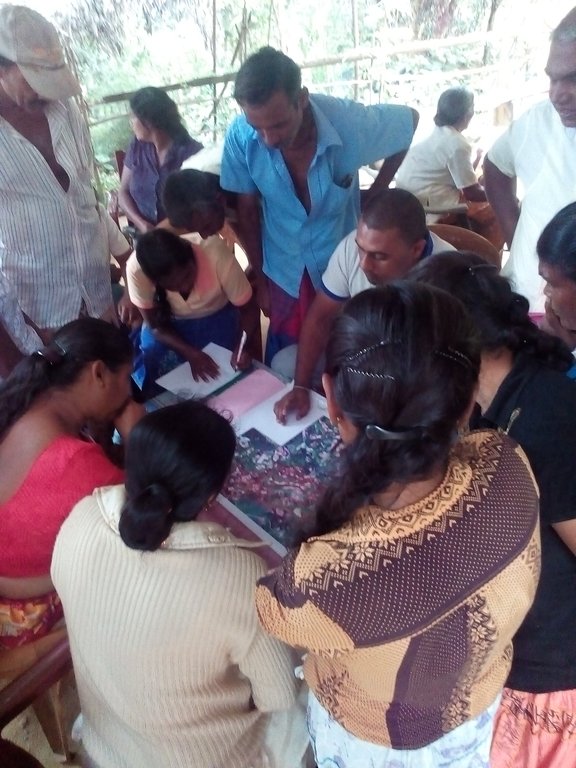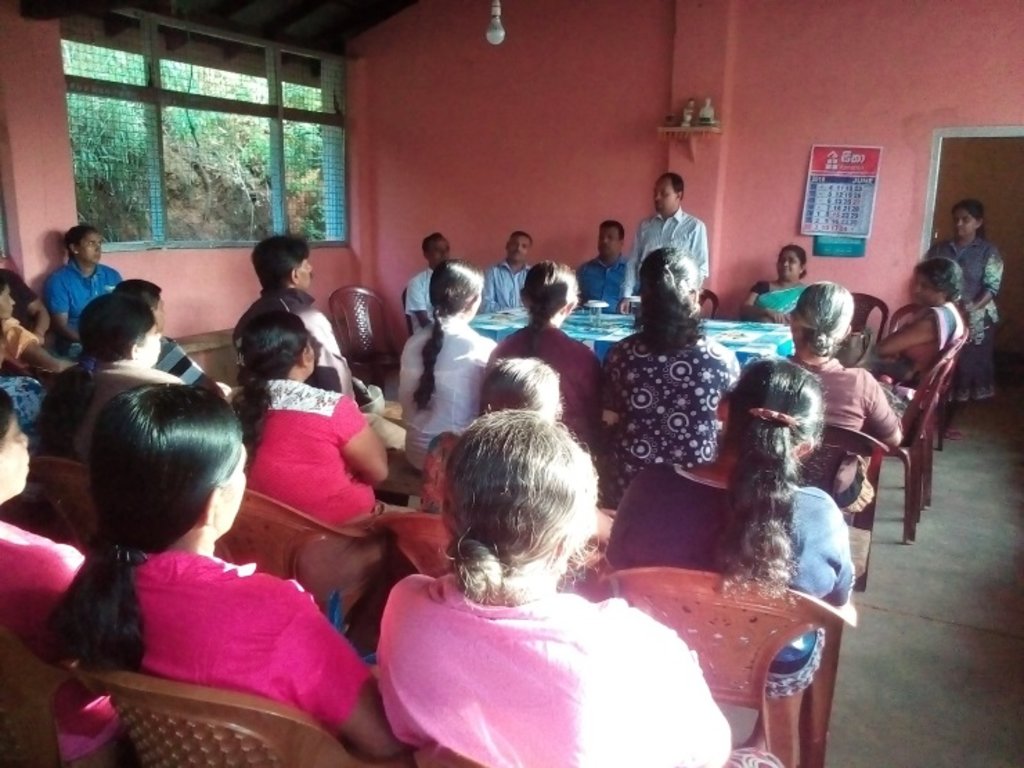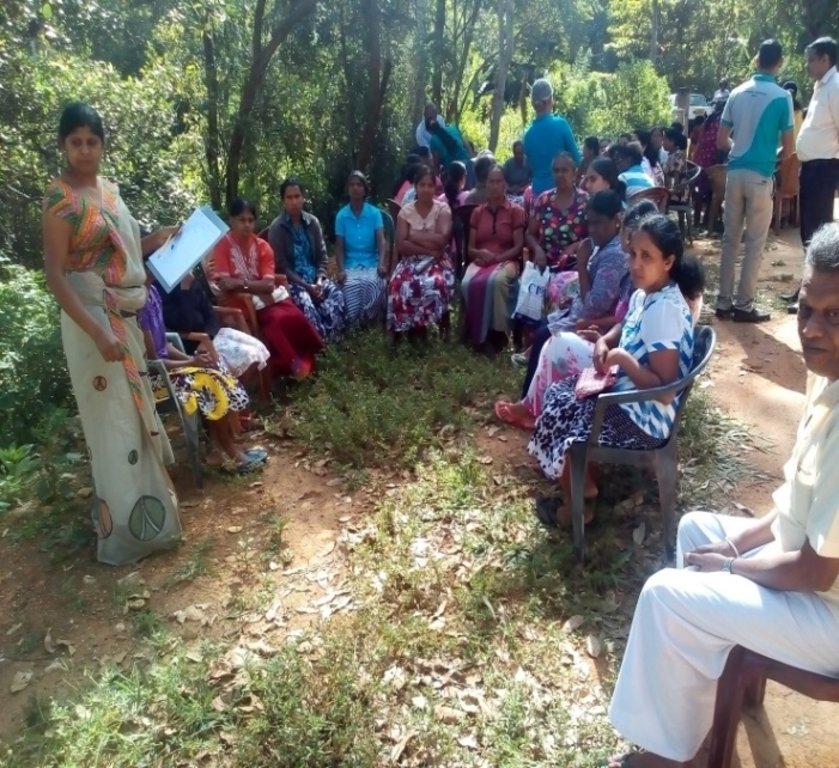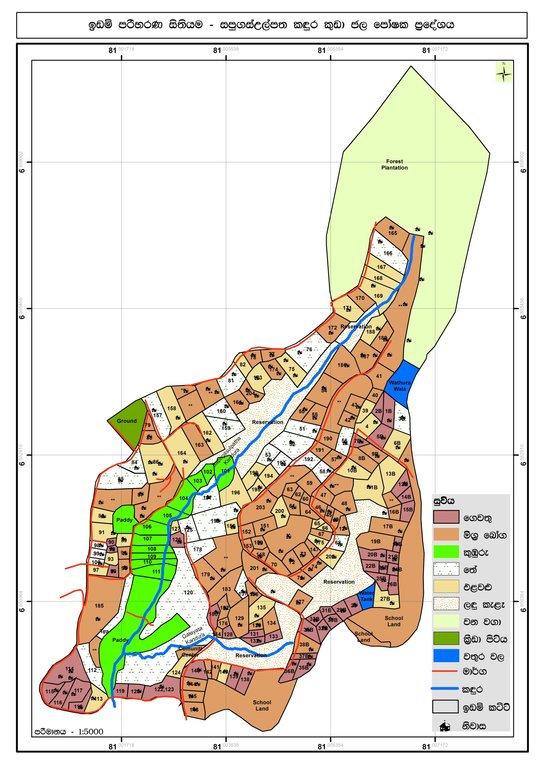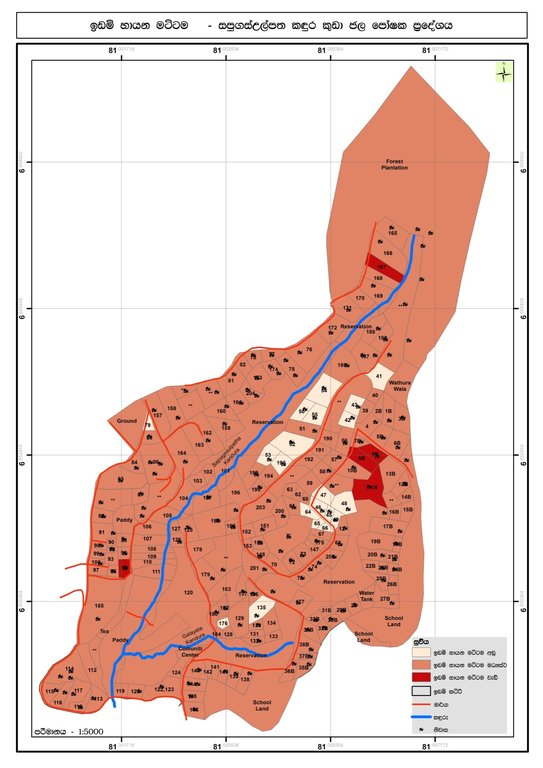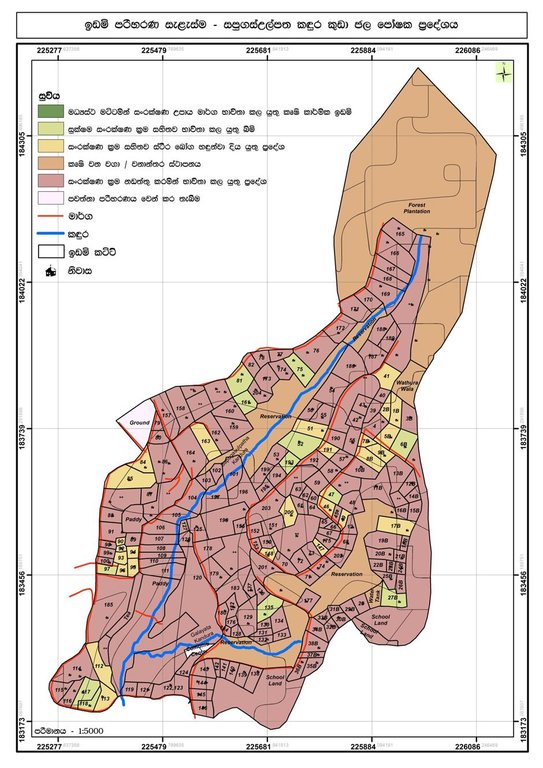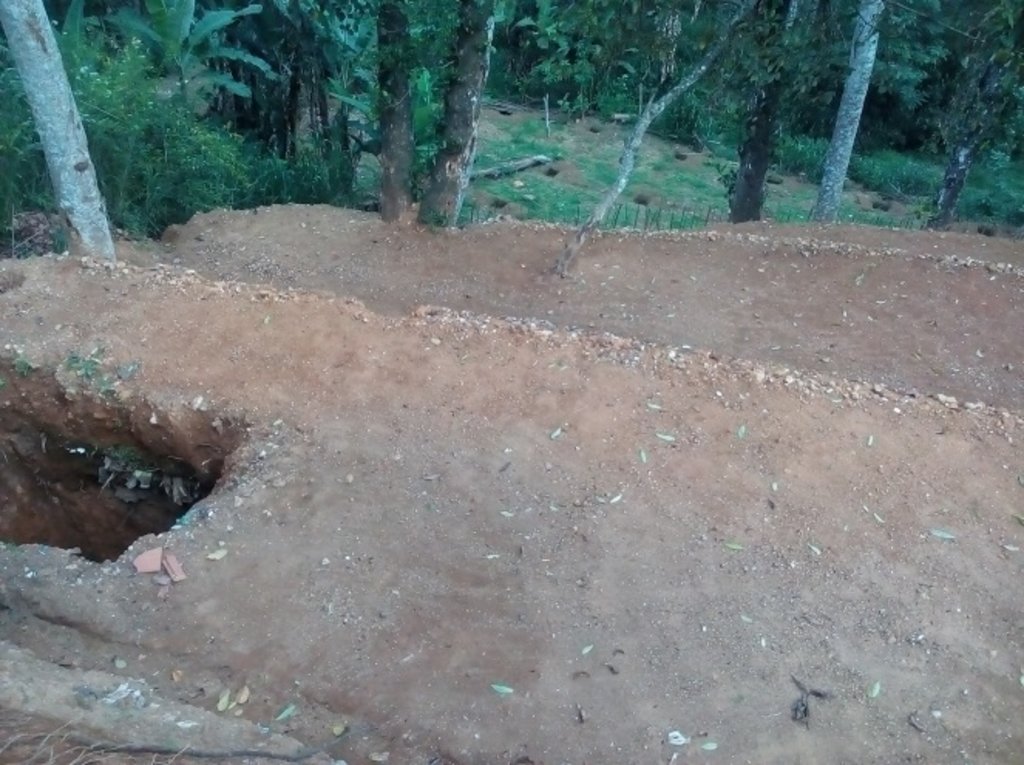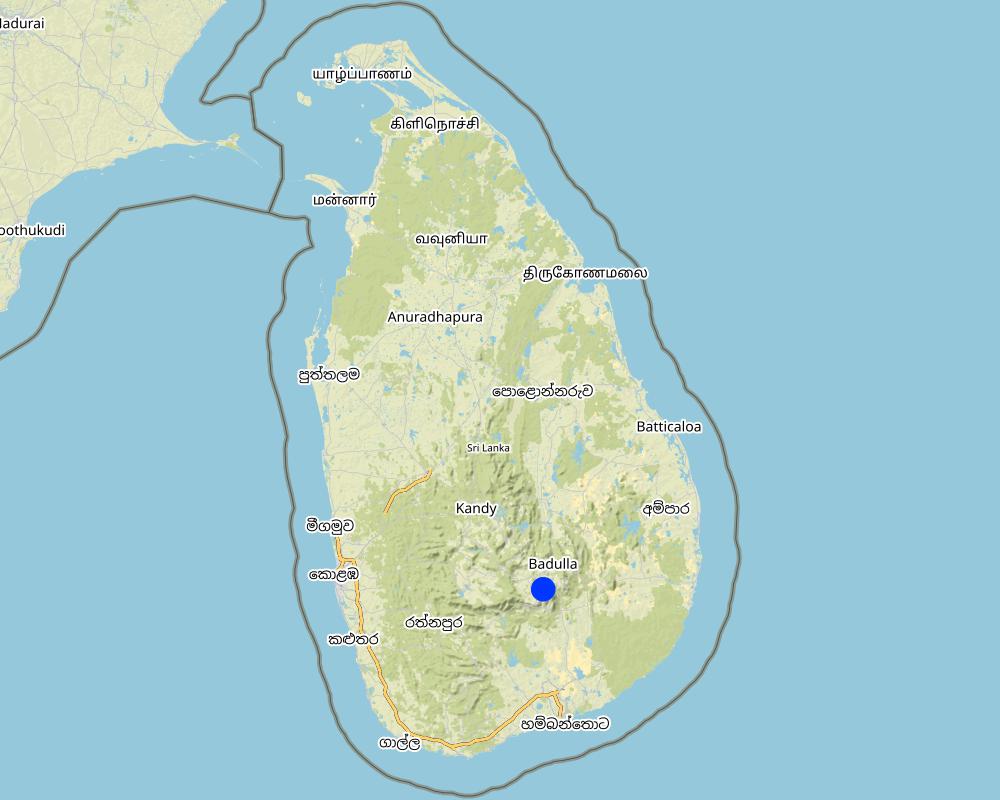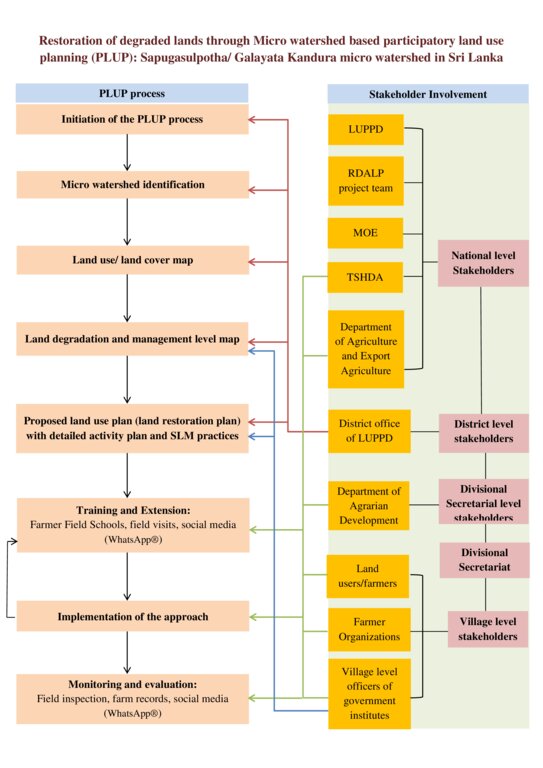Restoration of degraded lands through participatory land use planning [Sri Lanka]
- Création :
- Mise à jour :
- Compilateur : Head Soil Science
- Rédacteur : –
- Examinateurs : William Critchley, Rima Mekdaschi Studer
Village-based participatory land use planning
approaches_6237 - Sri Lanka
Voir les sections
Développer tout Réduire tout1. Informations générales
1.2 Coordonnées des personnes-ressources et des institutions impliquées dans l'évaluation et la documentation de l'Approche
co-compiler:
co-compiler:
Agrarian Research and Production Assistant:
Karunarachchi Mangalika
+94714955038
Department of Agrarian Development
Agrarian Research and Production Assistant Office, Galayata Kandura, Bindunuwewa, Bandarawela.
Sri Lanka
exploitant des terres:
Podimenike W.M.
+94572232842
Galayata Kandura, Bindunuwewa, Bandarawela.
Sri Lanka
Nom du projet qui a facilité la documentation/ l'évaluation de l'Approche (si pertinent)
Rehabilitation of Degraded Agricultural Lands in Kandy, Badulla and Nuwara Eliya Districts in the Central Highlands of Sri LankaNom du ou des institutions qui ont facilité la documentation/ l'évaluation de l'Approche (si pertinent)
Faculty of Agriculture, University of Peradeniya, Sri Lanka (AGRI.PDN) - Sri Lanka1.3 Conditions relatives à l'utilisation par WOCAT des données documentées
Quand les données ont-elles été compilées (sur le terrain)?
24/02/2022
Le compilateur et la(les) personne(s) ressource(s) acceptent les conditions relatives à l'utilisation par WOCAT des données documentées:
Oui
2. Description de l'Approche de GDT
2.1 Courte description de l'Approche
Microwatershed-based participatory land use planning is a systematic and interactive process that primarily focuses on the optimal allocation of village land resources according to needs and demands of the people while promoting sustainable land management. Key features of this approach are multi-sectoral coordination, multi-stakeholder engagement and the active participation of land users throughout the participatory land use planning process.
2.2 Description détaillée de l'Approche
Description détaillée de l'Approche:
The Sapugasulpatha/ Galayata Kandura microwatershed is located in Bandarawela Divisional Secretariat (DS), Badulla District, Sri Lanka. Unsustainable land management has led to land degradation causing associated challenges. There was a need to identify strategies for restoration of degraded lands while addressing water scarcity. In 2018, the Rehabilitation of Degraded Agricultural Lands Project (RDALP) introduced participatory land use planning (PLUP) for this microwatershed. Previously, stakeholders were dealt with individually. But the PLUP process relies on the active involvement of all stakeholders. Key is microcatchment level planning - embedded in multi-sectoral coordination and multi-stakeholder engagement.
The process is initiated by the district office of the Land Use Policy Planning Department (LUPPD). Firstly, the LUPPD identifies microwatersheds and develops land use/cover maps. It is assisted by the Bandarawela DS, which is the administrative body for lands in the area and has the capacity to coordinate all relevant stakeholders. Then, officers of the LUPPD meet with community leaders, representatives of farmer organizations and field level officers to verify the land use maps through field visits. Demarcation of individual plots on these maps is also carried out. Next, a field visit is conducted with all stakeholders to identify the status of land degradation and the current crop management practices. This is, effectively, “training of trainers”. Subsequently, the community prepares maps of land degradation and management types with the support of LUPPD.
This is followed by a participatory rural appraisal (PRA) process with all stakeholders. In the PRA, issues related to land degradation/use, ownership, conflicts and socio-economic concerns are discussed. Participants come to an initial consensus on solutions. After this, a detailed action plan is prepared and stakeholders identified. The next stage involves the development of land use plans for the entire microwatershed targeting the restoration of degraded and poorly managed lands. The land use plan covers both on-farm and off-farm land, and provides recommendations for SLM practices over the entire microwatershed: it serves as a detailed land restoration plan. Then, detailed discussions are held with specific stakeholders to prepare sector-based plans. This includes detailed plans for individual farms. As an example, officers of Tea Smallholdings Development Authority (TSHDA) provide inputs to develop detailed plans for smallholder tea cultivation - including plans for individual farmers. Subsequently, implementation is performed jointly by stakeholders. If, for example, a farm is identified for tea cultivation intercropped with export crops, officers both from TSHDA and the Department of Export Agriculture extend their support. The approach includes farmer field schools (FFS) conducted by the Department of Agrarian Development officers and project officers of RDALP. Moreover, farmers are encouraged to use social media (WhatsApp®) to share their knowledge and experiences with SLM practices. The local community is also exposed to examples of good SLM through field visits. The final step is evaluation and monitoring. This is performed by the officers of the Agrarian Service Development, RDALP, and also by individuals. A divisional agricultural committee is mandated to perform continuous monitoring of implementation. PLUP provides the stimulus for farmers to continue SLM - since practices are not enforced but identified themselves. Further, firm bonding is established between land users and other stakeholders, including government institutes, strengthening the likelihood of sustainability.
2.3 Photos de l'approche
2.4 Vidéos de l'Approche
Commentaire, brève description:
https://youtu.be/uHBRGYVT--M
Participatory Land Use Planning for Sustainable Land Management
Date:
03/08/2021
Lieu:
Dambugasagala, Welimada
2.5 Pays/ région/ lieux où l'Approche a été appliquée
Pays:
Sri Lanka
Région/ Etat/ Province:
Badulla District - Uva province
Autres spécifications du lieu :
Watagamuwa Grama Niladhari Division, Bandarawela Divisional Secretariat Division
Map
×2.6 Dates de début et de fin de l'Approche
Indiquez l'année de démarrage:
2018
Date (année) de fin de l'Approche (si l'Approche n'est plus appliquée):
2021
Commentaires:
Stakeholders continue to provide extension service for this microwatershed, even though the project was finished.
2.7 Type d'Approche
- fondé sur un projet/ programme
2.8 Principaux objectifs de l'Approche
1)Identification and mapping of degraded lands at microwatershed level.
2)Integration of multi-sectoral coordination and multi-stakeholder engagement in participatory land use planning implemented at village micro watershed level.
3)Identification of land management related issues and factors contributing to land degradation and prioritizing sustainable land use/management options through participatory approach.
4)Development and implementation of a land use plan and an action plan to restore and mitigate the degradation within the micro watershed employing PLUP approach.
5)Maintenance and promotion of ecosystem services for the sustainability of rural livelihoods.
6)Reduction of the pressure of competitive land use on natural resources.
2.9 Conditions favorisant ou entravant la mise en œuvre de la(des) Technologie(s) appliquée(s) sous l'Approche
normes et valeurs sociales/ culturelles/ religieuses
- favorise
Greater social capital as local community is well organized with a strong social bonding among villagers. Farmer organization with leaders appointed by villagers further strengthened the bonding between people for agriculture/ land management related activities.
- entrave
Lack of interest of young generation on farming.
disponibilité/ accès aux ressources et services financiers
- favorise
Having access to a comprehensive land use plan for each land increases access for financial resources such as loan facilities from banks, subsidy schemes of TSHDA, Loan facilities of tea factories. Farmers have the option to come with an agreement with a leading supermarket chain in Sri Lanka to obtain financial services/materials with the promise of supplying the products exclusively to the said supermarket chain.
- entrave
Existing financial wellbeing of farmers and land ownership related issues limits the access.
cadre institutionnel
- favorise
National, regional and village level institutional set up is existing. Moreover, farmer organizations have strengthened the collective power of farmers to coordinate with institutes. Female farmers have formed “Sithamu” Women's Farmers' Organization and both female and male farmers in the village have formed “Galayata Kandura” Rural Farmer Organization. Land use plan serves as a common platform for the collaboration between institutes enhancing the overall synergy.
- entrave
Often the lack of coordination between sectoral institutes and top-down approach in decision making. Lack dedicated institutes to coordinate activities at national level.
collaboration/ coordination des acteurs
- favorise
Officers of relevant government institutes namely, DS, LUPPD, Extension service of the Department of Agriculture, Department of Agrarian Development, Department of Export Agriculture and TSHDA are willingly to support farmers. Moreover, RDALP project officers play an important role in coordinating the activity.
cadre juridique (régime foncier, droits d'utilisation des terres et de l'eau)
- favorise
Majority of farmers own their lands (home gardens and tea smallholdings). Legal frameworks of land ownership and land and water usage are well established.
- entrave
Delays and complications in solving legal issues pertaining to land use
cadre politique
- favorise
Land use policy, soil conservation act, national action plan (NAP) to combat land degradation
- entrave
Lack of implementation of policies and acts
gouvernance foncière (prise de décisions, mise en œuvre et application des décisions)
- favorise
Presence of land use committee (at divisional level) and divisional agriculture committee (included all government institutes related to land use) for decision making. The DS is the chairperson of these committee who is also a part of the PLUP process. Farmers have the liberty to take land use decisions within the framework of land use policy and administrative framework. However, field level officers representing government institutes such as LUPPD, Department of Agriculture, Department of Export Agriculture, TSHDA play a supporting role in implementation of these decisions. Absence of Gender biasedness is a very important factor.
- entrave
Land ownerships, conflicts on land ownership, illegal encroachment of sensitive areas of the micro watershed and political interferences
connaissances sur la GDT, accès aux supports techniques
- favorise
Farmer organizations serve as a platform to share knowledge on SLM. Strong village level extension service is facilitated by the Department of Agriculture, Export Agriculture, TSHDA and other technical services. These officers are available at Agrarian Service Centre and Wednesdays are allocated for meeting with farmers. Moreover, conducting field visits is a part of their duty. Farmer groups have been identified and introduced social media platforms such as WhatsApp® to share SLM knowledge by experts and among themselves. Farmers are capable of operating online interaction facilities such as Zoom® allowing experts to share the knowledge conveniently.
- entrave
Inadequacy of extension officers
marchés (pour acheter les intrants, vendre les produits) et prix
- favorise
Farmers have the choice of marketing their products and enter into the value chain i.e. direct selling at the village vegetable market, private companies those visit to the field for purchasing their products (vegetable, spice crops and tea) and intermediate buyers. Farmers also have the option to come into a contract with a leading supermarket chain to sell their products if they are willing to adopt Good Agricultural Practices (GAP).
- entrave
Lack of transport facilities, low market price offered by intermediate buyers, price fluctuations
charge de travail, disponibilité de la main-d'œuvre
- favorise
Most of the SLM practices which are promoted through this approach are not very labor-intensive. Often, family members are sufficient to establish the majority SLM practices.
- entrave
Lack of labor force due to the labor migration
3. Participation et rôles des parties prenantes impliquées dans l'Approche
3.1 Parties prenantes impliquées dans l'Approche et rôles
- exploitants locaux des terres / communautés locales
Land users/ village farmers (both men and women)
Express their willingness to involve in PLUP. They are involved in the entire process by actively participating for group discussions and activities with other stakeholders to identify land use related issues, prepare a community land use plan, identify SLM practices and implementation. Further, participation for training programmes and share the knowledge about SLM practices.
- organisations communautaires
“Sithamu” Women's Farmers' Organization and “Galayata Kandura" Rural Farmer Organization
All farmers of the village are members of these community based organizations. These serve as a platform to promote the involvement of farmers in the PLUP process. Moreover, problems/issues arise in the process are discussed within the organization to come up with socially agreed solutions.
- Spécialistes de la GDT/ conseillers agricoles
LUPPD, Department of Agriculture, Department of Export Agriculture, Department of Agrarian Development, TSHDA
Identification of village level micro-catchments by LUPPD
Introducing SLM technologies
Provision of training
Oversee the implementation and monitoring the success of field adopted SLM technologies
- gouvernement local
DS office of Bandarawela, Department of Agrarian Development, TSHDA, Department of Agriculture and Department of Export Agriculture
Involved in the PLUP process as key stakeholders responsible for advisory services, conflict resolution, capacity building and overall implementation and monitoring
- gouvernement national (planificateurs, décideurs)
LUPPD, Ministry of Environment (MOE), Natural Resource Management Centre of the Department of Agriculture
Support the preparation of land use plans within the context of legal frame work of the country
- organisation internationale
Food and Agriculture Organization (FAO), Global Environment Facility (GEF)
Project coordination, partial financial support, Capacity building
Si plusieurs parties prenantes sont impliquées, indiquez l'organisme chef de file ou l'institution responsable:
LUPPD
3.2 Participation des exploitants locaux des terres/ communautés locales aux différentes phases de l'Approche
| Participation des exploitants locaux des terres/ communautés locales | Spécifiez qui était impliqué et décrivez les activités | |
|---|---|---|
| initiation/ motivation | interactive | Community leaders, LUPPD, DS and RDAL Project officers. The process is initiated by the district office of LUPPD which is the responsible national level authority to prepare sustainable land use plans. The regional office identifies village level micro catchment and develop land use/cover maps. The DS serves as a body that coordinate the activity by linking relevant stakeholders. |
| planification | interactive | Community leaders, land users, LUPPD, DS and RDALP officers. Planning of the PLUP process is performed by these parties. |
| mise en œuvre | interactive | Land users, community leaders, Department of Agrarian Development, Department of Agriculture, Department of Export Agriculture, TSHDA, officers of RDALP, other officers representing different agriculture sectors and land users. Implementation of the restoration plan for individual farm is performed jointly by different stake holders. As an example if a farmers` land is identified for tea cultivation intercropped with export agricultural crops, officers both from TSHDA and Department of Export Agriculture extend their support for implementation. |
| suivi/ évaluation | interactive | Land users, Department of Agrarian Development, RDALP officers, individual stakeholders, Department of Agriculture, officers of Natural Resource management Centre and divisional agricultural committee. Please note that participatory monitoring mechanism was implemented. |
| Marketing | auto-mobilisation | Land users (farmers), private companies and intermediate sellers. Farmers have the choice of marketing their products by direct selling at the village vegetable market, through private companies those visit to the field for purchasing their products (vegetable and tea) and intermediate buyers. Moreover, farmers also have the option to come into a contract with a leading supermarket chain to sell their products if they are willing to adopt Good Agricultural Practices (GAP) |
3.3 Diagramme/ organigramme (si disponible)
Description:
The PLUP described above is focused on restoration of degraded lands at microwatershed level. The multi-sectoral coordination and multi-stakeholder engagement throughout the process are key features of this process leading to the preparation of detailed restoration plan at on-farm and off-farm levels promoting sustainable land management.
Auteur:
Prof. W.A.U. Vitharana
3.4 Prises de décision pour la sélection de la Technologie/ des Technologies
Indiquez qui a décidé de la sélection de la Technologie/ des Technologies à mettre en œuvre:
- tous les acteurs concernés dans le cadre d'une approche participative
Expliquez:
This is a participatory approach in which stakeholders make collective decisions on the selection of appropriate technologies. Multi-stakeholder engagement is a prominent characteristic.
Spécifiez sur quelle base ont été prises les décisions:
- l'évaluation de connaissances bien documentées en matière de GDT (prises de décision fondées sur des preuves tangibles)?
- les résultats de recherches?
- expériences et opinions personnelles (non documentées)
4. Soutien technique, renforcement des capacités et gestion des connaissances
4.1 Renforcement des capacités/ formation
Une formation a-t-elle été dispensée aux exploitants des terres/ autres parties prenantes?
Oui
Spécifiez qui a été formé:
- exploitants des terres
- personnels/ conseillers de terrain
Si pertinent, spécifiez le genre, l'âge, le statut, l'ethnie, etc.
Training was provided for both men and women farmers of the microwatershed
Formats de la formation:
- entre agriculteurs (d'exploitants à exploitants)
- zones de démonstration
- réunions publiques
Formats de la formation:
- social media (WhatsApp®) and online meetings via Zoom® platform
Thèmes abordés:
Sustainable Land Management practices, compost preparation, liquid fertilizer preparation, water harvesting techniques, soil conservation practices and pruning of fruit trees
Commentaires:
Farmers have shown a great interest on sharing knowledge and experiences through the social media
4.2 Service de conseils
Les exploitants des terres ont-ils accès à un service de conseils?
Oui
Spécifiez si le service de conseils est fourni:
- dans les champs des exploitants?
- dans des centres permanents
Décrivez/ commentez:
Well organized advisory service is available in Sri Lanka which is conducted through the field officers of the Department of Agriculture, Export Agriculture, TSHDA. These officers are available at Agrarian Service Centre and Wednesdays are allocated for meeting with farmers and making field visits is a part of their job. Moreover, members of the project team RDALP also served as trainers. Importantly, community leaders and farmer organization representatives were trained as trainers to assure the sustainability.
4.3 Renforcement des institutions (développement organisationnel)
Des institutions ont elles été mises en place ou renforcées par le biais de l'Approche?
- oui, modérément
Spécifiez à quel(s) niveau(x), ces institutions ont été renforcées ou mises en place:
- local
- régional
Décrivez l'institution, ses rôles et responsabilités, ses membres, etc.
The PLUP process strengthens the institutional coordination and their roles at village level.
Précisez le type de soutien:
- financier
- renforcement des capacités/ formation
- équipement
- infrastructure
Donnez plus de détails:
Details are provided in Table 6.3
4.4 Suivi et évaluation
Le suivi et l'évaluation font ils partie de l'Approche? :
Oui
Commentaires:
Field level government officers are entrusted with the monitoring process with the participation of land users
Si oui, ce document est-il destiné à être utilisé pour le suivi et l'évaluation?
Non
4.5 Recherche
La recherche a-t-elle fait partie intégrante de l’Approche?
Non
5. Financement et soutien matériel externe
5.1 Budget annuel de la composante GDT de l'Approche
Si le budget annuel précis n'est pas connu, indiquez une fourchette:
- 10 000-100 000
Commentez (par ex. principales sources de financement/ principaux bailleurs de fonds):
GEF and local government institutions
5.2 Soutiens financiers/ matériels fournis aux exploitants des terres
Les exploitants des terres ont-ils reçu un soutien financier/ matériel pour la mise en œuvre de la Technologie/ des Technologies?
Oui
Si oui, spécifiez le(s) type(s) de soutien, les conditions et les fournisseurs:
Financial support for soil conservation, materials for preparation of nursery sheds (4x4 feet), vegetable seeds and fruit plants for home gardening, tea seedlings for infilling and polythene for rain water harvesting ponds
5.3 Subventions pour des intrants spécifiques (incluant la main d'œuvre)
- main d'œuvre
| Dans quelle mesure | Spécifiez les subventions |
|---|---|
| en partie financé | Subsidy for establishment of soil conservation structures |
- équipement
| Spécifiez les intrants subventionnés | Dans quelle mesure | Spécifiez les subventions |
|---|---|---|
| machines | entièrement financé | Pruning kits for fruit tree management, Portable hole drilling machine* for establishment of tea plantations, Bush cutters*, selective plucking machines. *Provided for the Village farmer society |
| outils | entièrement financé | Nursery trays |
- intrants agricoles
| Spécifiez les intrants subventionnés | Dans quelle mesure | Spécifiez les subventions |
|---|---|---|
| semences | entièrement financé | Vegetables seeds |
| Fruit plants, Tea seedlings | entièrement financé | Fruit plants for home gardening and intercropped with tea, tea seedling for infilling |
- matériaux de construction
| Spécifiez les intrants subventionnés | Dans quelle mesure | Spécifiez les subventions |
|---|---|---|
| UV treated Polyethene | entièrement financé | UV treated Polyethene for water harvesting ponds and nursery sheds |
- infrastructures
| Spécifiez les intrants subventionnés | Dans quelle mesure | Spécifiez les subventions |
|---|---|---|
| Rainwater storage tank | entièrement financé | Rainwater storage tank to harness water for micro watershed and the downstream areas as ground water |
Si la main d'œuvre fournie par les exploitants des terres était un intrant substantiel, elle était:
- volontaire
Commentaires:
Most of the time family members are engaged with field activities
5.4 Crédits
Des crédits ont-ils été alloués à travers l'Approche pour les activités de GDT?
Non
5.5 Autres incitations ou instruments
D'autres incitations ou instruments ont-ils été utilisés pour promouvoir la mise en œuvre des Technologies de GDT?
Oui
Si oui, spécifiez:
Land use policy and agriculture policy of Sri Lanka are overarching instruments. Moreover, regulations identified in the Soil Conservation Act of Sri Lanka promote SLM technologies.
6. Analyses d'impact et conclusions
6.1 Impacts de l'Approche
Est-ce que l'Approche a autonomisé les exploitants locaux des terres, amélioré la participation des parties prenantes?
- Non
- Oui, un peu
- Oui, modérément
- Oui, beaucoup
All land users are part of the approach which empowered land users on knowledge on land degradation, SLM practices and preparation of detailed restoration plan for degraded/poorly management lands. Moreover, training programs and field visits empowered land users with specific skills.
Est-ce que l'Approche a permis la prise de décisions fondées sur des données probantes?
- Non
- Oui, un peu
- Oui, modérément
- Oui, beaucoup
The participatory approach includes field visits, analysis of field evidences to identify degraded lands and lands those have not been properly managed. These allow land users on evidence based decision making to implement SLM practices.
Est-ce que l'Approche a aidé les exploitants des terres à mettre en œuvre et entretenir les Technologies de GDT?
- Non
- Oui, un peu
- Oui, modérément
- Oui, beaucoup
The entire process help land users to understand user specific sustainable land management options and also integrate local knowledge and experience. Since SLM options are identified by land users it enables them to implement based on available resources. Involvement relevant stakeholders (e.g. Agriculture extension officers) and training programs help land users for the implementation and maintenance of SLM technologies. Partial financial support and material support further help farmers to implement and maintain SLM practices.
Est-ce que l'Approche a amélioré la coordination et la mise en œuvre de la GDT selon un bon rapport coût-efficacité?
- Non
- Oui, un peu
- Oui, modérément
- Oui, beaucoup
Multi-sectoral coordination embedder throughout the process improve coordination among stakeholders. The SLM practices which are identified by land users assured to be cost-effective and manageable.
Est-ce que l'Approche a mobilisé/ amélioré l'accès aux ressources financières pour la mise en œuvre de la GDT?
- Non
- Oui, un peu
- Oui, modérément
- Oui, beaucoup
Involvement of key institutes in the process and documentary evidence on proposed activities enhance the access to financial resources for SLM implementation.
Est-ce que l'Approche a amélioré les connaissances et les capacités des exploitants des terres pour mettre en œuvre la GDT?
- Non
- Oui, un peu
- Oui, modérément
- Oui, beaucoup
Land users are trained on SLM by providing on-ground hands on experience and through online sessions. Farmers are motivated from others who have already implemented SLM practices.
Est-ce que l'Approche a amélioré les connaissances et les capacités des autres parties prenantes?
- Non
- Oui, un peu
- Oui, modérément
- Oui, beaucoup
Interaction between stakeholders is a dominant activity throughout the process. This allows knowledge sharing leading to improve capacities of all stakeholders. FAO officers, Extension officers and officers of Department of Agrarian Development visit each land plot and give further instructions
Est-ce que l'Approche a construit/ renforcé les institutions, la collaboration entre parties prenantes?
- Non
- Oui, un peu
- Oui, modérément
- Oui, beaucoup
Multiple institutions are involved in this approach and they work together in the process of land use planning.
Est-ce que l'Approche a conduit à améliorer la sécurité alimentaire et/ou la nutrition?
- Non
- Oui, un peu
- Oui, modérément
- Oui, beaucoup
Increased production of vegetables and fruits through appropriate land use planning and SLM practices enhance the village level food security
Est-ce que l'Approche a conduit à améliorer l'accès à l'eau et l'assainissement?
- Non
- Oui, un peu
- Oui, modérément
- Oui, beaucoup
Establishment of rainwater harvesting ponds has been integrated to land use plan. Further, establishment of village level water harvesting tank increase the ground water status. This lead to access for irrigation water during the dry season.
Est-ce que l'Approche a amélioré la capacité des exploitants des terres à s'adapter aux changements/ extrêmes climatiques et a atténué les catastrophes liées au climat?
- Non
- Oui, un peu
- Oui, modérément
- Oui, beaucoup
Soil conservation practices and SLM practices lead to enhancement of soil organic carbon levels. Further, rainwater harvesting ponds sustain the water supply during extreme drought periods. These will contribute to the enhance climate resilience potential.
Est-ce que l'Approche a conduit à des emplois, des opportunités de revenus?
- Non
- Oui, un peu
- Oui, modérément
- Oui, beaucoup
Increase in farmer income is expected through appropriate land use planning and application of SLM practices. Especially, crop diversification options introduced and increased irrigation water availability through rain water harvesting will enhance income opportunities. E.g. intercropping of spice crops (export agricultural crops) with tea as one of the consequences of this approach
6.2 Principale motivation des exploitants des terres pour mettre en œuvre la GDT
- augmenter la production
Increased production from home gardens and tea smallholdings
- augmenter la rentabilité/ bénéfice, rapport coûts-bénéfices
Increased crop yields, thus profits are expected through proper land allocation and application of SLM practices
- réduire la dégradation des terres
Reduced land degradation (specially soil erosion) achieved through SLM practices such as application of soil conservation measures (stone bunds, terraces, contour farming) and application of organic fertilizers (compost) produced by farmers.
- réduire les risques de catastrophe
Soil conservation practices reduce the risk of earth slips which are prevalent in the area. Rainwater harvesting ponds reduce the risk of droughts.
- paiements/ subventions
Subsidies were provided to implement soil conservation practices. Material support was provided for the preparation of rain water harvesting ponds, establishment of nurseries, and operations in tea lands.
- améliorer les connaissances et compétences en GDT
Land users understand the importance of SLM application for their lands through participatory approach and farmer field schools.
- améliorer l'esthétique
Aesthetic value of home gardens were improved and it is given extra income for the family.
6.3 Durabilité des activités de l'Approche
Les exploitants des terres peuvent-ils poursuivre ce qui a été mis en œuvre par le biais de l'Approche (sans soutien extérieur)?
- oui
Si oui, décrivez de quelle manière:
There is a greater potential for farmers to continue SLM practices since such practices are not forcefully enforced but identified by land users themselves through a participatory approach. Therefore, SLM technologies identified by farmers suit to their socio-economic capacity. Further, strong bonding is established with land users and other stakeholders such as government institutes, that will lead to the sustainability of the approach.
6.4 Points forts/ avantages de l'Approche
| Points forts/ avantages/ possibilités du point de vue de l'exploitant des terres |
|---|
| Multi-sectoral coordination and multi-stakeholder engagement throughout all activities of the approach |
| Land users perceive a sense of ownership of the SLM practice implemented through the approach |
| Training programmes conducted through online platforms motivate farmers to implement SLM on their own land while improving the awareness on SLM practices |
| Greater potential of enhancement of the farmer income through practices such as crop diversification, intercropping etc. |
| Enhanced food security |
| Points forts/ avantages/ possibilités du point de vue du compilateur ou d'une autre personne ressource clé |
|---|
| Field evidence suggested farmers have willingly embraced the approach to restore their degraded lands |
| The approach has enhanced collaborations with land users and other stakeholders |
| The approach has inculcated ownership of the entire process on land users |
6.5 Faiblesses/ inconvénients de l'Approche et moyens de les surmonter
| Faiblesses/ inconvénients/ risques du point de vue de l’exploitant des terres | Comment peuvent-ils être surmontés? |
|---|---|
| Marketing of Vegetables | Though farmers has access to village vegetable market, if farmers can be incorporated to the Good Agricultural Practices (GAP) program this limitation can be overcome. |
| Lack of financial resources | Formally link a financial supporting institute as a key stakeholder (e.g. Banks, social protection schemes) |
| Lack of labor | Though land users identified less labor intensive SLM practices, the provision of necessary machinery could have substitute such practices with more appropriate ones. |
| Time constraints of land users to participate continuously | Use of ICT tools and scheduling meetings at convenient times for land users |
| Faiblesses/ inconvénients/ risques du point de vue du compilateur ou d'une autre personne ressource clé | Comment peuvent-ils être surmontés? |
|---|---|
| PLUP approach is a time consuming process | Simplify the PLUP process |
| This approach requires a large number of officers to carry out | Simplify the PLUP process |
| Incompatibility of micro-watershed boundaries and administrative boundaries | Use administrative boundaries in planning process |
| Negative attitude of some institutions and some officials towards collective effort | National level stakeholders should be made aware of the project activities and incorporate them into their plans |
| Some stakeholders' involvement exceeds beyond their mandate | Ensuring that each institution executes their mandate and the due respect for their intervention |
7. Références et liens
7.1 Méthodes/ sources d'information
- visites de terrain, enquêtes sur le terrain
One field visit
- interviews/entretiens avec les exploitants des terres
Three families were interviewed
- interviews/ entretiens avec les spécialistes/ experts de GDT
RDAL project officers, Agriculture Research and Production Assistants
- compilation à partir de rapports et d'autres documents existants
Healthy Soil Matters (FAO, United Nations Colombo, 2021)
7.2 Références des publications disponibles
Titre, auteur, année, ISBN:
Healthy Soil Matters, The Food and Agriculture Organization of the United Nations Colombo, 2021
Disponible à partir d'où? Coût?
SriCAT website
Titre, auteur, année, ISBN:
Guidelines for participatory land use planning
Disponible à partir d'où? Coût?
LUPPD
7.3 Liens vers les informations pertinentes disponibles en ligne
Titre/ description:
Healthy Soil Matters, The Food and Agriculture Organization of the United Nations Colombo, 2021
URL:
https://sricat.net/index.php/en/media-gallery/documents/248-healthy-soil-matters
Liens et modules
Développer tout Réduire toutLiens
Aucun lien
Modules
Aucun module trouvé


